
In this Wix SEO guide, we provide a simple, step-by-step guide that you can follow to ensure that your Wix website ranks highly in search results.
Let’s start with something that’s quick and easy to do, but also really important: telling search engines that your site exists.
1. Make sure you’re using a custom domain name
If you’re using the free version of Wix, you are by default given a ‘wixsite.com’ domain name — ‘yoursite.wixsite.com’ etc.
However, search engines and their users tend to trust custom domain names more than the standard Wix ones — using them can lead to better search rankings.
(A custom domain name would be something like ‘yourstorename.com’ etc.)
So make sure that:
- you register a relevant domain name for your site (this will mean upgrading to a paid Wix plan, but the SEO value of this is worth doing so)
- you connect the domain to your Wix website
- you set your custom domain name as your primary domain (this stops Google getting confused by the existence of multiple domains).
You can learn more about connecting a domain to Wix here.
2. Register your site with Google Search Console and Bing Webmaster tools
Registering your site with Google Search Console and Bing Webmaster Tools is a key starting point for Wix SEO.
By registering your site with these services, you’re telling Google and Bing about your website and helping it to get indexed faster.

This process is very straightforward — but if you need help, there are two resources available for Wix users that will guide you through the process:
Once you’ve registered your website with Search Console and Bing Webmaster Tools, you then need to submit an XML sitemap to them.
Helpfully, Wix creates your sitemap automatically for you — it’s simply yourdomain.com/sitemap.xml.
In both Search Console and Bing Webmaster Tools, you can submit this sitemap URL by going to your site’s dashboard, and then clicking ‘sitemaps.’
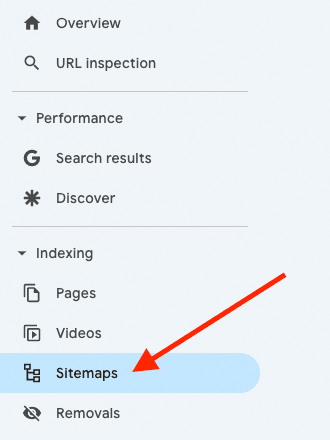
Then, just follow the simple instructions provided to complete the sitemap submission process.
💡 Tip: if local SEO is a key concern, and particularly if you are going to be operating a ‘brick and mortar’ style business in addition to a website, you should register your site with Google Business too. This lets you add your site to Google Maps, which are often featured in search results.
Once you’ve set up your Google Business profile, make sure you keep it up to date, especially where opening hours are concerned — this will increase the chances of your business being featured in local searches.
3. Do your keyword research
A vital part of improving your Wix site’s search rankings is ensuring that its pages and products contain the keywords that people are actually searching for. This means doing some keyword research.
Keyword research involves establishing three main things:
- the keywords that people are using when looking for sites or products like yours
- the volume of searches for those keywords
- how difficult it is to rank for each keyword (this is determined by the number of websites that already rank highly in search results for those specific keywords).
When you have these three pieces of information, you can identify ‘sweet spots’ – keywords that are popular enough to generate a decent amount of traffic, without being so popular that there are lots of other sites already dominating search results for them.
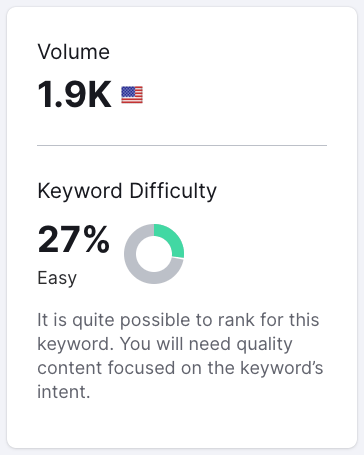
The video below shows you how to do basic keyword research with Semrush.
4. Ensure your site is loading quickly
Search engines can give fast sites preference over slower ones.
To ensure that your Wix website loads as quickly as possible,
- Avoid using a large number of web fonts on your site.
- Use image compression tools to reduce the size of any images you upload to your Wix site.
- Avoid over-use of any external scripts or custom code on your site.
- Avoid using animation effects on your site.
5. Get your page titles right
One of the most important elements of a web page is its title. Search engines treat it as a key piece of information when categorizing your content, and it shows up as the largest component of a search result.
You should ensure that your Wix page titles are never vague in nature, and always start with your target keyword.
To edit a page title in Wix, locate that page in your site’s dashboard. Then, click the three dots beside the page name, and then on ‘SEO Basics.’
Use the ‘title tag’ field to add or edit the page title.
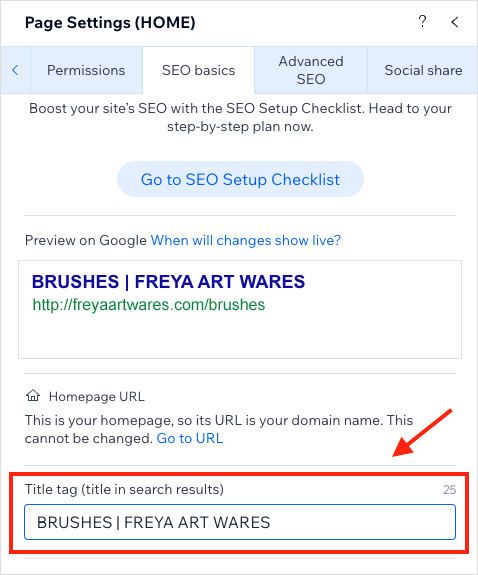
If you want to edit the page title for a blog post, a slightly different process is involved — you’ll need to edit the post in question and then click the ‘SEO’ icon on the left of the interface.
Then, use the title tag field to add or edit the post title.
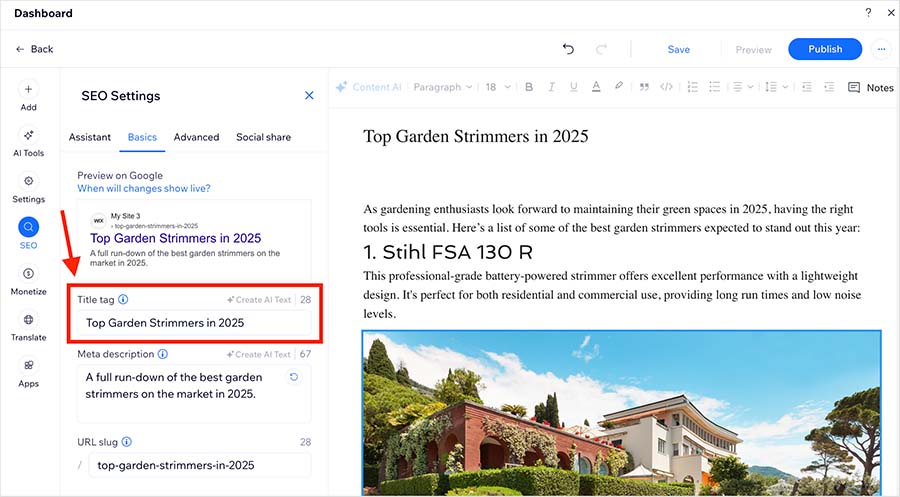
6. Use headings properly
Rather than using bold text to break up the text for the content on your Wix site, always apply Heading 1s, 2s, 3s and so on to do so.
Applying headings is very easy in Wix — just double click on a piece of text to access its settings. Then, use the ‘Style’ dropdown provided to apply the correct heading to it.
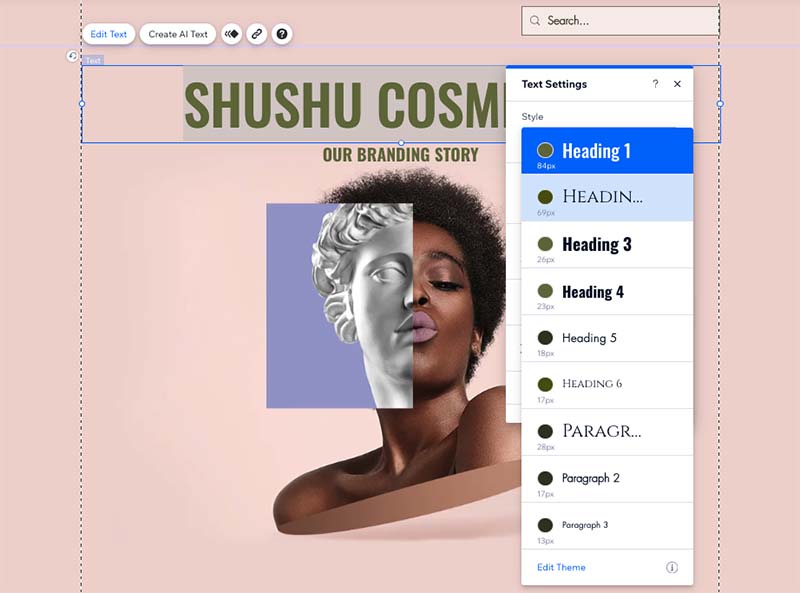
Using headings in this way will make it easier for search engines to index your content accurately, and will also make it more accessible to any of your site visitors who have a visual impairment and use screen readers.
The primary title of your webpage, known as the ‘H1’, is the most important because search engines use it to understand the main theme of your content.
So ensure that each page has only one H1, and that it includes the primary keyword you’re targeting.
Utilizing H2 and H3 headings properly helps both readers and search engines understand your content more easily — so ensure that you include relevant keywords in these too.
7. Use engaging meta descriptions
Meta descriptions are the summaries of web pages that appear under page titles in search results.
Although Google says that they aren’t a ranking factor, a well-written meta description can encourage more clickthroughs to your website.

And because the clickthrough rate of a search result IS considered a ranking factor, it’s important to get meta descriptions right.
Your meta description for your Wix pages, products and posts should:
- be short (ideally around 120 to 156 characters in length)
- be accurate
- include your target keywords.
To edit the meta description of a page in Wix, go to that page in your site’s dashboard. Then, click the three dots beside the page name, followed by the ‘SEO Basics’ option. You’ll then have the option to add or edit its meta description.
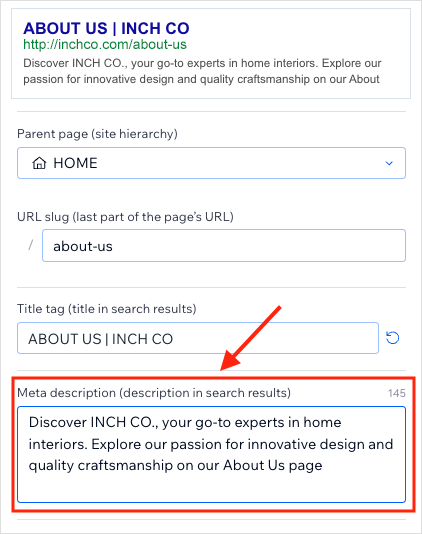
A similar process is involved with editing meta descriptions for blog posts and products — simply locate your post or product, access the SEO settings and then edit your meta description.
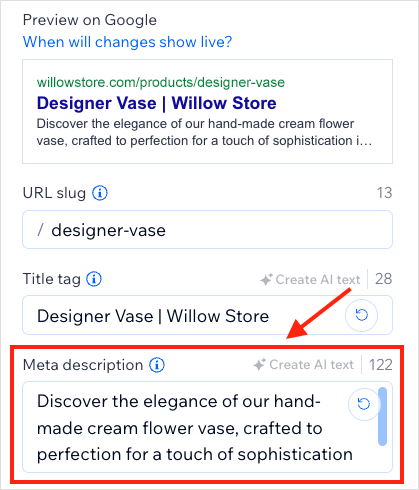
8. Ensure your page titles and descriptions are unique
A common way of speeding up the process of adding content or products to a Wix website involves using the ‘Duplicate page’ option.
While this gives you a very quick way to add a new page to your Wix site, it can lead to a lot of similar or even entirely duplicated titles and descriptions being created by mistake.
This is something that search engine algorithms don’t particularly like, so always remember to make your titles and descriptions as unique and as relevant as possible.
9. Optimize your alt text and image names
Search engines don’t just examine the words on your website when indexing it — they consider its images too.
To do this, they look at two bits of data associated with your pictures: ‘alt text’ and file names.
To add alt text to an image on your Wix site, click on the image and then on the cog icon that appears. You’ll then be able to access the image’s settings, which include a ‘What’s in the image?’ field. This is where you can enter your alt text.
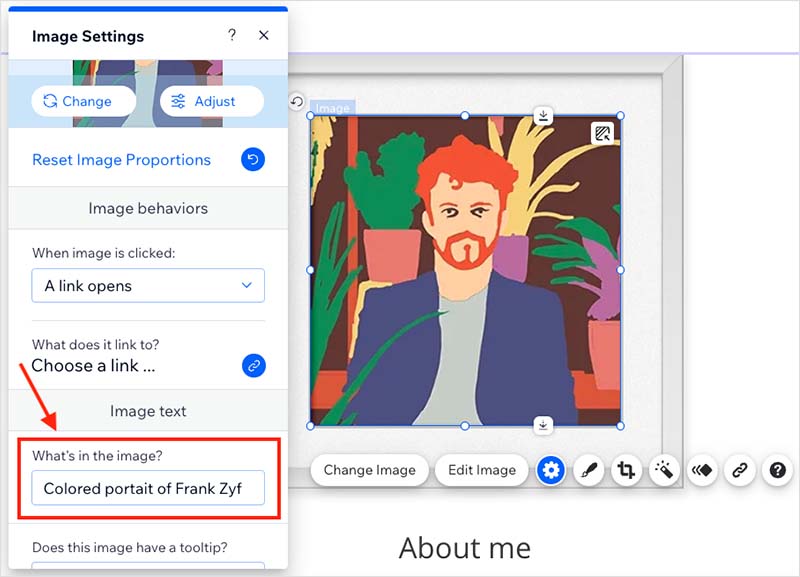
When adding your alt text, make sure that it contains any necessary target keywords (while still ensuring that your description makes sense to those using screen readers).
As for optimizing file names, you’ll need to go to Wix’s ‘Media Manager’ section to do this. This is accessible via the picture icon on the left hand side of your dashboard.
Once there, click on the ‘show more’ button underneath your images. This will take you to your full image library. Hover over the image with the file name you want to change, click the ‘three dots’ icon and then use the ‘rename’ option to give the image a new file name.
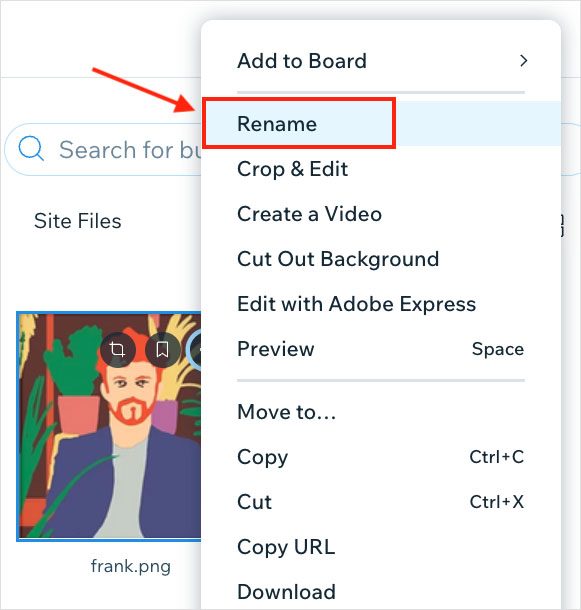
When doing this, ensure that your focus keyword is in the file name, and that the file name is short.
10. Use clean URLs
Using ‘clean’, SEO-friendly URLs is something that is encouraged by Google. Clean URLs are short, simple and easy to understand, and contain relevant keywords too.
For example, if you were selling a green guitar on your Wix store, it would be better to use a URL slug of yoursite.com/green-guitar for the relevant product page instead of something long and complicated .
To edit a URL in Wix, go to the page, product or post you wish to edit, access its SEO settings, and locate its URL.
Then, enter your URL into the ‘URL’ field in the box provided.
Now, if you are changing an existing URL, you’ll need to create a redirect to it. Doing so prevents users (and Google!) encountering broken links, and lets Google know that you have changed the URL.
Depending on the Wix plan you’re on, and the type of content you’re working with, you may find that Wix creates redirects automatically for you. If not, you can use Wix’s redirect manager to create and edit them.
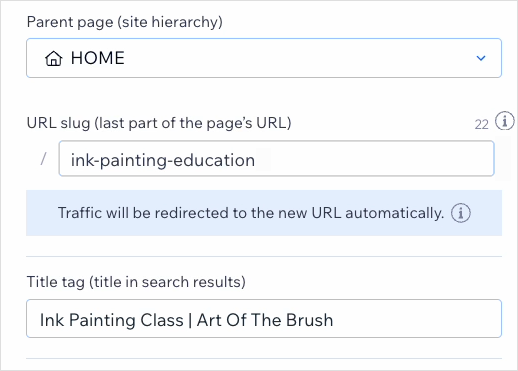
Now, changing the URLs of pages that aren’t currently performing well in search results is usually fine — but if you’re thinking about changing the URL of a page that IS already ranking highly, it’s often best to take an ‘if it ain’t broke don’t fix’ it approach.
Although Google can usually cope with the URL of a popular page being changed, sometimes some algorithm weirdness does happen and you can lose traffic.
(Changing the URL will also affect its ‘social proof’, because it will reset the stats displayed on your social shares counter for that page to zero.)
11. Add rich snippets to your content
Rich snippets are pieces of ‘structured data’ that can be added to your content to help search engines and users understand what a page is about.
Rich snippets provide additional information about the content of a product, page or post — for example, star ratings, author or prices.

To do this you’ll need to manually add some Schema markup code to your Wix pages or products. You can learn more about how to do this here.
12. Use your Wix blog to drive traffic
Sites that feature in-depth, informative blog posts on topics that people are interested in tend to perform much better in search results than those that don’t.
Wix comes with a good blogging tool, so make sure you make the most of it — you should aim to regularly post high-quality posts about key topics in your product niche.
You can learn more about how to blog effectively in our detailed guide to increasing blog traffic here, or for a quick overview, just check out the video below.
13. Build backlinks to your site
Backlinks are links from another site to yours, and they are a really important part of SEO.
This is because search engines consider backlinks as ‘votes’ for the quality of a piece of content. Generally speaking, the more backlinks you have to the products, posts and pages on your Wix site, the higher they’ll rank in search results.
To obtain backlinks, you usually have to ‘reach out’ to other site owners in your niche and persuade them to link to your content. This can be hard — but it’s easier to do if the content you’ve created on your store is really strong.
One thing that you should be careful about is buying links — search engines disapprove of this practice and can penalize your site in search results if they discover evidence of it.
Link swap schemes can be risky too.
14. Ensure your site is trustworthy
Google prioritizes sites that are trustworthy. It looks for ‘E-E-A-T signals’ on websites, with this acronym standing for Experience, Expertise, Authoritativeness, and Trustworthiness.
You can add E-E-A-T signals to your Wix website by ensuring that it contains:
- an about page
- valid contact details
- a privacy policy
- a refund policy
- website terms and conditions
- author biographies.
Getting links from authoritative sites to yours can also help considerably with establishing trust.
💡Tip: You can leaarn more about Google’s ‘E-E-A-T’ guidelines in Google’s Search Quality Evaluator Guidelines.
Additionally, our post on ‘How to Recover from a Google Core Update‘ provides some additional tips on how to help Google view your site content as trustworthy.
More Wix SEO advice
The above tips should have a positive impact on your Wix website’s search engine ranking, but there is much more to learn about SEO.
For a deeper understanding of SEO best practices, then please do subscribe to our mailing list. You’ll gain access to exclusive, practical advice that can further enhance your Wix site’s search engine performance. Just complete the form below!
Don’t miss out on our free SEO toolkit
For a limited time only we’re offering our readers some excellent free SEO tools and resources. Sign up now to immediately receive:
- our downloadable cheatsheet containing the 20 key steps to ranking highly in search results
- extended free trials and discounts for leading SEO tools
- our downloadable cheatsheet on how to grow organic traffic to a blog
- 2 in-depth guides to SEO
- ongoing free tips and advice on SEO and growing your business
Any thoughts on Wix SEO?
We hope these Wix SEO tips are helpful and they boost your Wix website’s position in search results. If you have any questions, please feel free to leave a comment below. We’ll do our best to answer!
Wix SEO checklist FAQ
Is Wix good for SEO?
The Wix website builder offers robust SEO features that allow for easy management of essential tasks like adding alt text, customizing URLs, editing meta descriptions and integrating with Google Search Console. Wix also provides a handy ‘SEO Assistant’ tool that is especially helpful for beginners, guiding them through SEO basics and integrating with Semrush for keyword research.
However, Wix’s approach to mobile site design, using separate versions for desktop and mobile instead of responsive design, can limit its SEO effectiveness a bit, because Google prefers responsive websites. Despite this, Wix sites are generally considered to perform well in search results.
It is important to remember that SEO for Wix sites depends not just on technical settings but also on factors like keyword research, content quality, and getting backlinks to your site.
Does Yoast work with Wix?
Unfortunately, the popular SEO tool, Yoast, does not work with the Wix platform. However, Wix’s built-in ‘SEO Assistant’ tool provides similar functionality for Wix blog posts.
How can I make a Wix website rank highly in search results?
There are quite a few steps you’ll need to take to ensure your Wix site ranks highly in search results, but the key ones are making sure that it (1) it is registered with Google Search Console, (2) always uses unique page and product descriptions, (3) contains compelling content for which keyword research has been carried out and (4) has high quality backlinks from authoritative and trustworthy sites pointing to it.
No comments